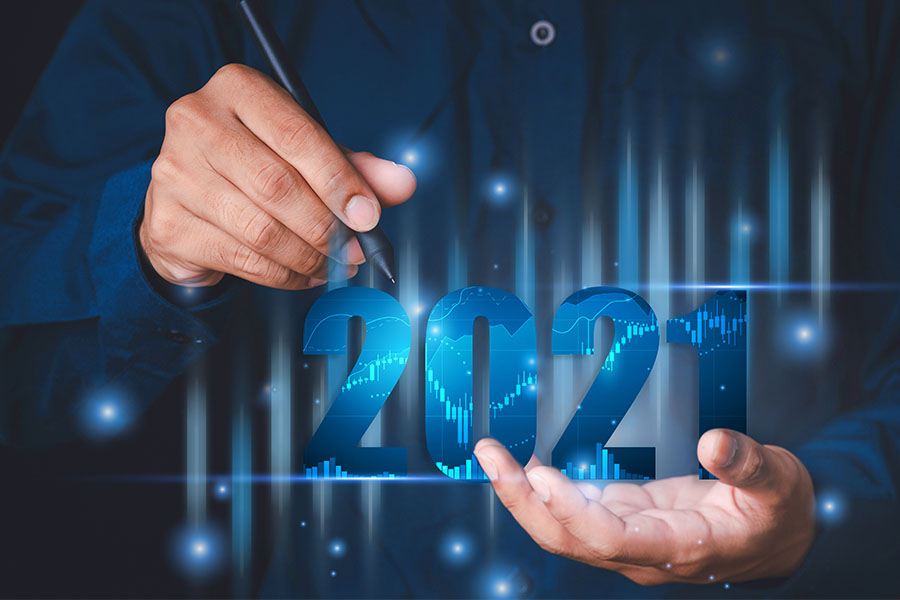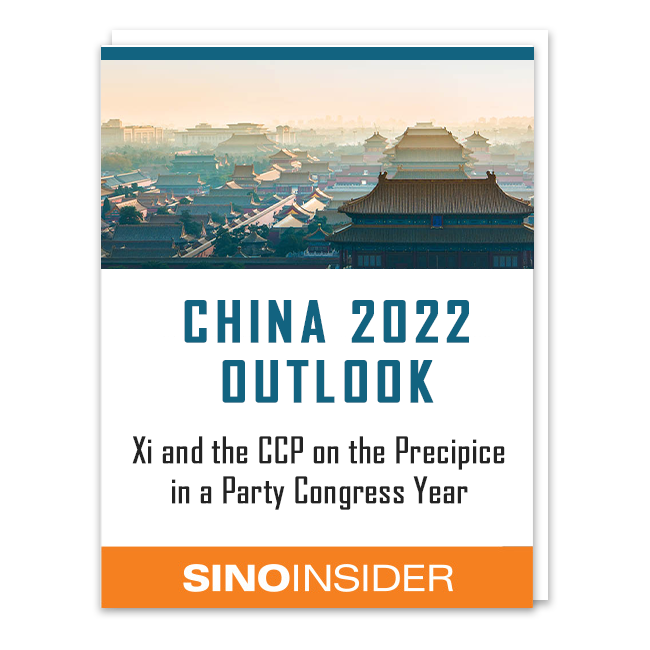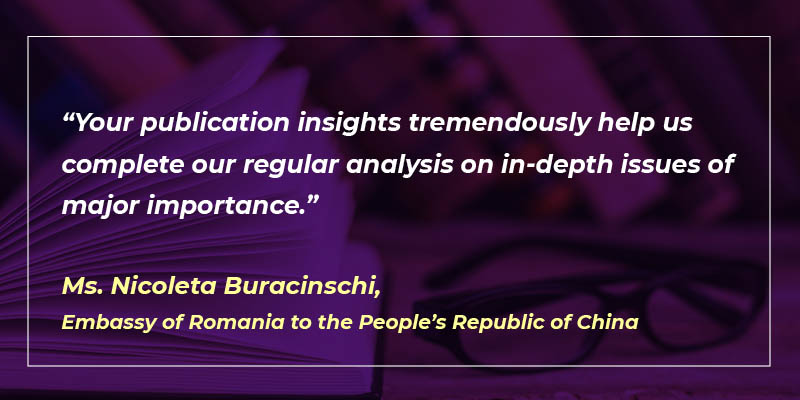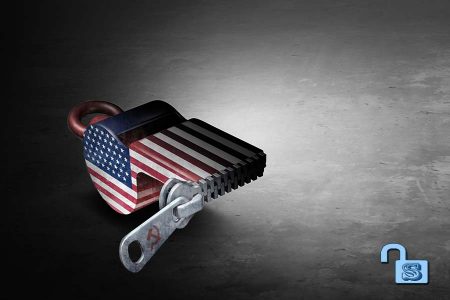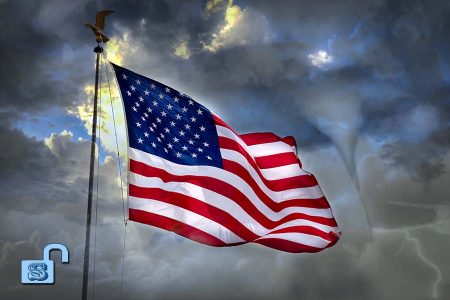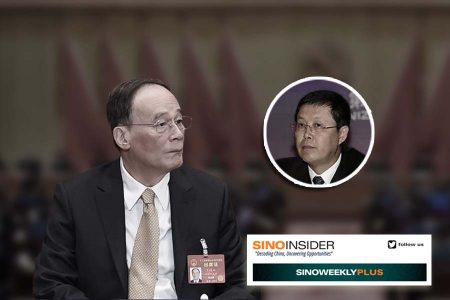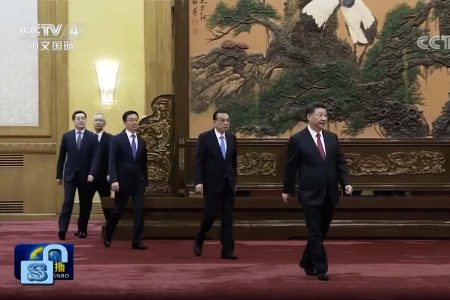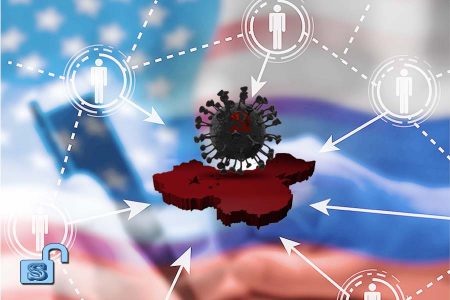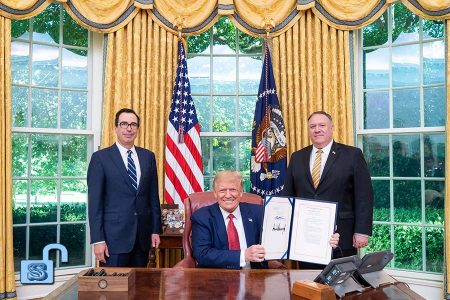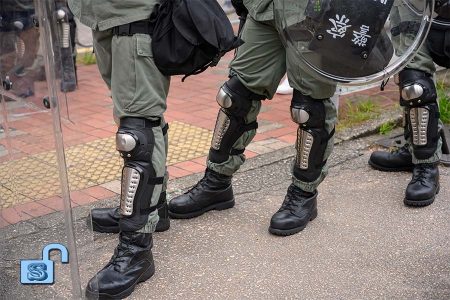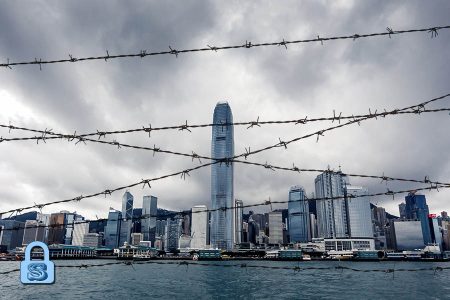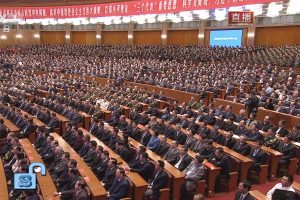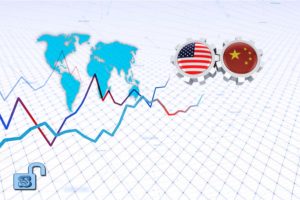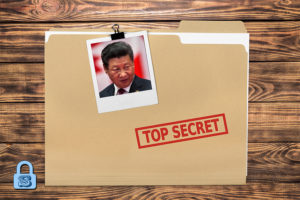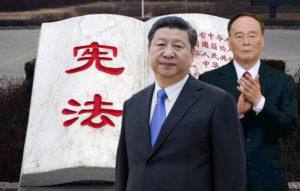◎ Our accuracy for 66 predictions is 56.1 percent, while the exclusion of the predictions involving a post-communist China is 66.1 percent.
We made 66 predictions covering nine categories in our updated China 2021 Outlook published on Jan. 30, 2021. Ten of those predictions were predicated on the occurrence of a scenario where China entered a post-communist era. A tally of all 66 predictions leaves us with a forecasting accuracy of 56.1 percent, while the exclusion of the predictions involving a post-communist China (to be disclosed should the scenario arise) gives us a forecasting accuracy of 66.1 percent.
On the whole, developments in 2021 indicate that our forecasts are directionally sound. As stated in the introduction of our China 2021 Outlook, the world saw financial, social, and geopolitical turmoil, including America’s disastrous withdrawal from Afghanistan, massive lockdown protests in Europe, and sharp inflation. Crackdowns on Chinese tech giants and the China Evergrande debt crisis also shook markets and contributed to global financial instability. Meanwhile, the U.S. lurched leftward under a new administration, and countries worldwide moved in an authoritarian direction as governments implemented pandemic prevention and control measures.
China’s deteriorating situation suggests that we could just be a little ahead of the curve with our 2021 predictions about the fate of the CCP regime. The “perfect storm” of internal and external problems facing Beijing intensified last year and are set to worsen further this year given developments thus far in early 2022. If Xi Jinping and the CCP cannot rescue the economy, avert disaster for the property sector, and find solutions for various domestic and foreign troubles before the 20th Party Congress, then our post-communist China predictions may yet come to pass.
Some of our key forecasts in 2021 include:
- The investigation of former justice minister and Central 610 Office director Fu Zhenghua.
- Taiwan’s economy grew 6.28 percent in 2021, the fastest rate of expansion in 11 years.
- Chinese Center for Disease Control and Prevention director Gao Fu admitted that PRC vaccines “don’t have very high protection rates.”
- China Evergrande’s debt crisis saw ratings agencies downgrade the company to “restricted default.” The PRC government’s handling of its case indicates that Evergrande is technically “bankrupt.”
- The Hong Kong government used the new national security law to suppress freedom of speech and outspoken media outlets in the city. However, the government has yet to take action against Falun Gong-linked media like The Epoch Times.
- The U.S. was both “soft” and “hard” on China. On the one hand, Washington eschewed ideological confrontation with the CCP and offered tariff exclusions to companies. On the other hand, Washington pressured the CCP over Xinjiang, Hong Kong, and Taiwan, including imposing sanctions on PRC and Hong Kong officials over human rights abuses.
Politics: 8 predictions, 3 verified
1. The Biden-Harris administration will be tough on China in areas that affect Xi Jinping’s prestige, including Xinjiang, Taiwan, Hong Kong, and the origins of the coronavirus. Heightened Sino-U.S. tensions in sensitive areas raises Xi’s personal political risks, and could lead to intra-Party calls for accountability. Xi’s factional rivals could also use “unrestricted warfare” tactics against him, including engineering or worsening an economic crisis, as well as creating or exploiting natural and man-made disasters. VERIFIED
- March:
March 22: Secretary of State Antony Blinken announced sanctions against PRC officials over “serious human rights abuse against members of ethnic and religious minority groups in Xinjiang.” In a statement, Blinken noted that “the PRC continues to commit genocide and crimes against humanity in Xinjiang.”
- October:
Oct. 21: The State Department issued a statement noting that the U.S. “remains seriously concerned at the continued erosion of human rights and fundamental freedoms, including political participation, in Hong Kong.”
Oct. 23: Secretary of State Antony Blinken issued a statement supporting Taiwan’s participation in the UN system. - December:
Mid-December: Former People’s Liberation Army Air Force general Liu Yazhou was placed under “internal control,” reportedly for expressing great dissatisfaction about Xi, questioning Xi’s ability to lead the CCP in ‘decisive battle’ over Taiwan, and for requesting a “change in commander-in-chief.” Dec. 23: President Joe Biden signed the Uyghur Forced Labor Prevention Act into law, “underscoring the United States’ commitment to combatting forced labor, including in the context of the ongoing genocide in Xinjiang,” according to a State Department statement.
2. Active or retired Party or state leaders could be investigated.
3. Active Central Committee members (full or alternate) and officials at the ministerial level could be investigated, including allies and supporters of Xi Jinping. VERIFIED
- October:
Oct. 2: Fu Zhenghua, a former justice minister and director of the Central 610 Office, was investigated.
- December:
Twenty-five central government cadres were purged in the whole of 2021, including two ministerial-level officials and 17 sub provincial-level officials.
4. The CCP will tighten surveillance and control over PRC officials. This will inspire more officials to flee China and even defect. VERIFIED
- September:
In September, Chinese netizens circulated a Central Commission for Discipline Inspection internal report containing data on “disapperances, flights, and suicides of corrupt officials in the 31 provinces and municipalities.” According to the data, there were eight provinces with over 300 fugitive officials, with Guangdong topping the list at 1,240 fugitives.
5. High-ranking CCP officials could be incapacitated by or succumb to the coronavirus or other contagious diseases. This will upset the balance of the CCP factional struggle.
6. The PRC central government may lose the ability to rescue provinces and territories when the “perfect storm” of problems (financial shortages, exploding debt crisis, contagious disease epidemic, etc.) facing the CCP regime becomes overwhelming. In this scenario, struggling provinces and territories could become semi-autonomous.
7. Political Black Swans are afoot when flight restrictions are suddenly imposed with no prior warning or martial law is declared in Beijing.
8. The PRC will meet its “Berlin Wall” moment.
Economics: 16 predictions, 10 verified
1. The PRC economy will see unprecedented shocks due to international financial turmoil, geopolitical pressures, and worsening epidemic situation. Many economic indicators could fall to record lows. VERIFIED
- December:
The PRC National Bureau of Statistics reported that China’s GDP grew by 8.1 percent to 114.367 trillion yuan in 2021 according to preliminary estimates. Growth in the fourth quarter was 4 percent (1.6 percent quarter-on-quarter), the lowest growth since the second quarter of 2020.
China’s national fixed asset investment increased by 4.9 percent to 54.455 trillion yuan in 2021. The growth rate declined sharply throughout the year, from 35 percent in the January-February period to less than 10 percent in August.
National real estate development investment in 2021 grew at 4.4 percent (compared with 38.3 percent at the start of the year) from last year to 14.7602 trillion yuan.
Total retail sales in 2021 increased by 12.5 percent from a year ago to 44.082 trillion yuan. Growth fell sharply throughout the year, from more than 30 percent during the January-February period to single digits in July, below 5 percent in August, and 1.7 percent in December.
According to data from the China Academy of Transportation Sciences, the China Passenger Transport Index scored 85.3 points in December 2021, a year-on-year decrease of 30.1 percent and a two-year average decrease of 28.0 percent. The index hit a low of 71.7 points in November, down 43.5 percent from 2020. Passenger traffic is a key indicator of economic activity in China.
In 2021, China’s total import and export volume increased by 21.4 percent year-on-year to 391.009 trillion yuan, with the trade surplus of 43.687 trillion yuan being the highest on record since 2015. However, data from the General Administration of Customs showed that the total value of goods imported from Hong Kong to the mainland was $9.7 billion, while Hong Kong’s statistics bureau showed exports from Hong Kong to the mainland at $378.6 billion; the $368.9 billion difference reduces China’s trade surplus by 54.5 percent.
2. The People’s Bank of China could cut its reserve requirements several times and adopt monetary easing policies. VERIFIED
- May:
May 11: The People’s Bank of China noted in its 2021 Q1 monetary policy implementation report that it would “cherish the normal monetary policy space.”
In an interview with People’s Daily, Dong Ximiao, China Merchants Union Finance chief researcher and part-time researcher at Fudan University’s Financial Research Institute, said that China’s monetary policy has become more “normal” at the “aggregate level.” Dong added that the PRC should stick to its current monetary and financial policies, not engage in excessive stimulus, strive to maintain “normal monetary policy,” and keep the macro leverage ratio “basically stable.”
- July:
July 15: The People’s Bank of China lowered the reserve requirement ratio of financial institutions by 0.5 percentage points, releasing about 1 trillion yuan of liquidity.
- December:
Dec. 15: The PBoC lowered the reserve requirement ratio of financial institutions by 0.5 percentage points across the board, releasing about 1.2 trillion yuan of liquidity.
3. China’s debt crisis will be triggered, resulting in a wave of defaults by local governments (urban investment bonds, local government financing vehicles, etc.), state-owned enterprises, and large private corporations. VERIFIED
- January:
Jan. 26: The CITIC Trust in Bozhou District (Guizhou Province, Zunyi Prefecture) defaulted on trust benefits payable to investors on Jan. 10, 2021, according to mainland media reports. The trust had about 255 million yuan in principal and came under the work unit of the Bozhou District government.
- April:
On April 1, China Huarong Asset Management delayed releasing its 2020 annual report and suspended trading of its stock. From April 5, investors began panic selling Huarong bonds. On April 27, Fitch Ratings downgraded Huarong from “A” to “BBB.”
- December:
Dec. 23: The Human Resources and Social Security Bureau of Hegang City in Heilongjiang Province issued a notice saying that it was canceling public recruitment for basic level government staff owing to the implementation of a financial reorganization plan by the city’s government and “major changes” in the city’s financial situation.
4. More small and medium-sized banks will encounter funding difficulties and even face bank runs. VERIFIED
- April:
April 28: Datong Bank, Changzhi Bank, Jincheng Bank, Jinzhong Bank, and Yangquan Commercial Bank were merged and reorganized to form Shanxi Bank.
- September:
Sept. 29: The China Banking and Insurance Regulatory Commission approved the merger of Liaoshen Bank with Yingkou Coastal Bank and Liaoyang Bank. According to the merger plan, Liaoshen Bank would absorb and merge with 12 of 15 city commercial banks in Liaoning Province.
- December:
Dec. 8: Zhongyuan Bank announced that its board of directors reviewed and approved relevant proposals for the merger of Luoyang Bank, Pingdingshan Bank, and Jiaozuo China Travel Bank.
5. Many financial institutions could find themselves being taken over by the PRC government or will declare bankruptcy.
6. China will continue reducing its holdings of U.S. Treasury bonds.
7. China’s foreign exchange reserves will come under pressure and shrink.
8. Foreign capital will withdraw from China on a large scale. The PRC government will use foreign exchange controls and other measures to prevent foreign capital from leaving. VERIFIED
- August:
Aug. 10: SoftBank Group announced that it would pause investing in China in the wake of regulatory action by the PRC authorities. “Until the situation is clearer we want to wait and see,” said SoftBank CEO Masayoshi Son.
- September:
Sept. 24: The People’s Bank of China and nine other departments issue notices stating that crypto-related transactions will be considered illegal financial activity, including services by offshores exchanges. The notices add that cryptocurrencies like Bitcoin and Tether are not fiat currency and cannot be circulated.
9. The renminbi exchange rate will fluctuate sharply and could depreciate to record lows.
10. Local government revenue will be greatly reduced. VERIFIED
- December:
Civil servants in many provinces and cities report salary reductions ranging from 20 percent to 30 percent. The first areas to report salary reductions include Jiangsu, Zhejiang, Guangdong, Fujian, and Shanghai.
Dec. 23: The Human Resources and Social Security Bureau of Hegang City in Heilongjiang Province issued a notice saying that it was canceling public recruitment for basic level government staff owing to the implementation of a financial reorganization plan by the city’s government and “major changes” in the city’s financial situation.
11. Several large property companies could file for bankruptcy. VERIFIED
- July:
China Evergrande Group’s debt crisis enters full swing. The developer owed suppliers, creditors, and investors a total of 1.9665 trillion yuan. Evergrande’s mid-year financial report (released June 30) showed that the firm’s net debt ratio had reached 99.8 percent, with an implicit debt estimated to be in the hundreds of billions or trillions of yuan (more than $156 billion, according to a Goldman Sachs estimate).
Evergrande’s debt situation indicates that it is in default and technically “bankrupt.”
- October:
Oct. 15: Chongqing Sincere Property was declared bankrupt and ordered to undergo reorganization by the Fifth Intermediate Court of Chongqing. Sincere ranked 91st out of the top 100 Chinese real estate companies in 2020. - December:
Dec. 6: Evergrande’s board of directors announced the establishment of a risk mitigation committee to tackle the operational and financial challenges facing the firm.
12. The PRC government could break up or shutter some prominent Chinese internet and technology companies. VERIFIED
- June:
June 16: Alibaba Group announced the split of Taobao into three companies, Taobao Marketplace, Taobao Mall and eTao.
13. Several large state-owned enterprises could declare bankruptcy. VERIFIED
- January:
Jan. 29: HNA Group announced that it was unable to finance its debts and had filed with a court for bankruptcy and reorganization.
- July:
July 9: One of Tsinghua Unigroup’s creditors requested that the company go into bankruptcy. On Dec. 15, the company submitted a debt restructuring plan to a court for approval.
14. Property prices will fall across the board. In first-tier cities, the selling of second-hand property will be very challenging. VERIFIED
- December:
The property price index of new commercial residential buildings in 70 medium- and large-sized cities peaked in April and May (62 cities up, 3 flat, 5 down) before declining continually until November (9 cities up, 2 flat, 59 down). The index for second-hand residential buildings peaked in March (58 cities up, 3 flat, 9 down) before hitting a bottom in November (3 cities up, 4 flat, 63 down). Prices for both indexes rebounded slightly in December.
15. Gold price in China will greatly fluctuate, and could hit record highs.
16. Food prices will rise sharply and there will be panic buying. VERIFIED
- November:
On Nov. 1, the PRC Ministry of Commerce issued a notice on “doing a good job in maintaining supplies and stabilizing prices of vegetable and other daily necessities in the market this winter and next spring” (關於做好今冬明春蔬菜等生活必需品市場保供穩價工作的通知). The notice read, “families are encouraged to store a certain amount of daily necessities according to their requirements to meet the needs of daily life and emergencies.” The notice triggered a wave of panic buying in mainland China, with many residents in Beijing, Chongqing, Henan, Jiangsu, and other places rushing to supermarkets and grocery stores to stock up on rice, flour, grain, and oil, according to mainland media reports. - December:
In 2021, China imported 165 million tons of grain and oil, an 18.1 percent increase from a year ago, according to official data. The average import price grew 17.8 percent year-on-year.
Domestic wheat prices fluctuated at a high level throughout 2021. On Jan. 1, the price of wheat was 2,456 yuan per ton, and on Dec. 31, the price had risen 15.8 percent to hit a record 2,844 yuan per ton.
Domestic corn prices rose to an annual high of 2,925 yuan per ton in early March, a year-on-year increase of 58 percent. The price later fell with large amounts of corn imports (up 152.2 percent year-on-year). On Dec. 31, the price of corn was 2,613 yuan, up 1.14 percent year-on-year.
On Jan. 6, 2022, the Food and Agriculture Organization of the United Nations released a report stating that its food price index for 2021 averaged 125.7 points, an increase of 28.1 percent from 2020.
Military: 3 predictions, 2 verified
1. Xi Jinping will continue to groom and promote a new military leadership guard (少壯派). Senior officers (colonel rank and above) could receive “rocket promotions” (破格提拔). VERIFIED
- July:
July 5: Xi Jinping promoted four senior officers to full general—Southern Theater commander Wang Xiubin, Western Theater commander Xu Qiling, PLA Ground Force commander Liu Zhenli, and PLA Strategic Support Force commander Ju Gansheng. - September:
Sept. 6: Xi Jinping promoted five senior officers to full general—PLA Western Theater Command commander Wang Haijiang, PLA Central Theater Command commander Lin Xiangyang, PLA Navy commander Dong Jun, PLA Air Force commander Chang Dingqiu, and PLA National Defence University president Xu Xueqiang.
All five generals held the rank of lieutenant general for less than four years; Lin Xiangyang was promoted to lieutanent general in July 2020.
2. The CCP will step up military maneuvers around its borders to intimidate neighboring countries, and even provoke small-scale conflicts. However, the CCP’s provocations will die down with the worsening of the domestic epidemic situation. VERIFIED
- January:
Jan. 20: Chinese and Indian troops clashed in north Sikkim at the Sino-Indian border. According to several Indian media, 20 PLA soldiers and four Indian soldiers were injured in the incident. The Indian army and PRC state media acknowledged that a “minor confrontation” had occurred and was “resolved.”
Jan. 27 – Jan. 30: The PLA conducted military drills in the western waters of Leizhou Peninsula in the South China Sea.
Jan. 31 – Feb. 1: The PLA conducted military maneuvers in the Bohai Sea.
Jan. 31 – Feb. 7: The PLA conducted military maneuvers in the Bohai Sea and the northern part of the Yellow Sea. - February:
Feb. 7 – Feb. 21: The PLA carried out military maneuvers in Bohai Sea and the northern part of the Yellow Sea.
Feb. 1: The CCP passed the “Maritime Police Law” (海警法). Subsequently, a total four Chinese coast guard ships entered the disputed water between the Senkaku Islands on Feb. 15 and Feb. 16.
- March:
March 1 – March 31: The PLA held various exercises in the South China Sea, including in the western water of Leizhou Peninsula between Hong Kong and Vietnam.
March 20: A task force of the Philippine government received a report that about 220 Chinese fishing ships not engaged in fishing activity were moored in the waters around Whitsun Reef as early as March 7. Philippine defense secretary Delfin Lorenzana called the presence of those vessels was a “clear provocative action of militarizing the area.”
- April:
April 4: The PLA aircraft carrier Liaoning and five escort frigates sailed through the Miyako Strait near Okinawa enroute to the Pacific Ocean.
April 15 – April 20: The PLA conducted a six-day live-fire drill in the waters near Pengjie Island in Hainan and the Taiwan-controlled Pratas Islands.
- May:
May 31: A group of 16 PLA military transport aircraft—Xi’an Y-20s and Ilyushin Il-76s—operating at altitudes between 23,000 and 27,000 feet flew in formation within 60 nautical miles of the coast of Sarawak, Malaysia. The Malaysian Air Force scrambled fighter jets to intercept and identify the PLA aircraft.
3. If the People’s Liberation Army becomes unusually quiet and inactive, this might be a sign that the military is struggling with severe epidemic conditions.
Society: 5 predictions, 5 verified
1. Coronavirus epidemic conditions could worsen in China, and new, harder to treat contagious diseases could emerge. In response, the CCP will seek to cover up the truth and blame other countries for the epidemic situation on the mainland. By the time the CCP finally admits that the crisis is serious, the epidemic will likely be beyond its control. VERIFIED
- February:
As of Feb. 5, 2021, the PRC government identified 10 high-risk and 49 medium-risk epidemic regions in China:
– Beijing Daxing District and Shanghai Pudong District: One high-risk community each;
– Shanghai: Three medium-risk areas;
– Heilongjiang: Seven high-risk areas and 41 medium-risk areas;
– Hebei: One high-risk area and four medium risk areas;
– Jilin: One high-risk area and one medium-risk area.
- July:
July 10: Nine vaccinated airplane cabin cleaners of the Nanjing Lukou International Airport were found to have been infected with the more contagious Delta strain of the SARS-CoV-2 coronavirus. The incident was only reported on July 20. The outbreak at the airport led to another nationwide epidemic wave.
2. China-produced vaccines may have serious quality defects, leaving those vaccinated susceptible to the coronavirus. VERIFIED
- April:
April 10: Gao Fu, director of the Chinese Center for Disease Control and Prevention, admitted that PRC vaccines “don’t have very high protection rates.”
- May:
May 5: World Health Organization experts expressed “very low confidence” in the data provided by PRC state-owned drugmaker Sinopharm on its COVID-19 vaccine concerning the risk of serious side effects in some patients.
3. China could see humanitarian crises stemming from food shortages and epidemics. VERIFIED
- August:
Aug. 3: A 36-weeks pregnant woman entering labor but trapped in lockdown in Yangzhou City, Jiangsu Province (listed as a high-risk area) sent a distress message on Weibo, according to the Chinese language edition of BBC. The woman was unable to give birth in a main urban area. BBC also noted that there were many distress calls in mainland China as a result of the various lockdowns.
- December:
Dec. 22: The Xi’an local government in Shaanxi Province announced the implementation of “zero-COVID” epidemic prevention measures and locked down the city. Residents were barred from leaving their homes to make purchases without a negative nucleic acid test from Dec. 27 after epidemic prevention and control measures were upgraded. Many residents took to the internet to complain of being starved to death due to a lack of food. Some hungry residents ended up trading coffee for eggs and cigarettes for instant noodles. On Dec. 31, a video circulating showed a man in Xi’an being beaten up by epidemic prevention personnel for breaking lockdown restrictions to buy steamed buns.
The draconian Xi’an lockdown also meant that many people were denied access to medical care; notable cases that garnered attention at the time include a pregnant woman and an eight-year-old boy suffering from leukemia. Others struggled to secure medicine essential for survival. On Dec. 30, a man died after failing to get medicine for lowering blood pressure. On Dec. 31, a man died suddenly after being rejected by three hospitals because he did not have a nucleic acid test.
4. The CCP could step up investigations and arrests of private entrepreneurs. VERIFIED
- February:
Feb. 9: Geng Xiaonan, a Chinese publisher who publicly supported dissidents and intellectuals, was sentenced to three years in prison by a Beijing court for “illegal business operations.” Geng was previously detained for five months.
- May:
May 7: Guangzhou dissident Wang Aizhong tweeted that dozens of police officers crashed a dinner event attended by seven or eight local entrepreneurs in Guangdong’s Zhongshan City on May 5 and took everyone away for questioning.
- July:
July 28: High-profile private entrepreneur Sun Dawu was sentenced to 18 years in prison by the Hebei Gaobeidian City Court.
- December:
Dec. 16: Wang Chaoyong, the founder and actual controller of Chinaequity Investment, was arrested by the economic crime investigation police, according to news reports. Wang is known as the “godfather of Chinese venture capital.”
5. Protests and other “mass incidents” could increase nationwide. Small-scale uprisings could break out at the local level, but not at the national level. VERIFIED
- June:
June 4 – June 10: Large-scale protest movements broke out in a number of independent professional schools and colleges in Jiangsu, Zhejiang, Shandong, Jiangxi, and other places over a plan by the authorities to merge independent college and vocational schools and “convert” students of those schools into vocational undergraduates.
- October:
Oct. 7: Hundreds of property owners from a small district in Zhejiang’s Hangzhou City protested the Ningbo branch of Ping An Bank for misappropriating funds earmarked for the exclusive use of property owners. The protesters also requested that the local government step in to resolve the issue of unfinished real estate developments. - December:
In 2021, there were 252 labor protests involving over 100 people, and 11 protests involving more than 1,000 people, according to China Labor Bulletin.
Hong Kong: 8 predictions, 5 verified
1. The CCP will keep using the Hong Kong National Security Law to suppress freedom of speech in the city. Media outlets who dare to speak out will be targeted to intimidate the rest. The CCP’s intention is to go after media outlets associated with Falun Gong when few Hong Kong media are willing to speak truth to power, but it may not succeed in bringing its plans to fruition depending on how 2021 unfolds. VERIFIED
- March:
March 10: Frank Lu Siqing, founder of the Information Centre for Human Rights and Democracy, announced that he was scrubbing the website to avoid accidentally “bumping” into the Hong Kong National Security law. The website, launched on Sept. 11, 2017, carried information pertaining to human rights abuses in China.
- June:
June 24: Under pressure from the Hong Kong National Security Law, pro-democracy Hong Kong tabloid Apple Daily printed its last edition, and shut down its website and mobile app.
June 27: Pro-democracy Hong Kong news site Post 852 announced that it would cease operations due to the social and political environment.
- July:
July 22: Hong Kong national security police arrested five members of the General Union of Hong Kong Speech Therapists for “conspiring” to publish “seditious” children’s books.
- November:
Nov. 4: Hong Kong localist media DB Channel announced that it would cease operations in Hong Kong to protect the safety of its employees.
- December:
Dec. 29: Pro-democracy Hong Kong media Stand News announced its closure after the Hong Kong national security police arrested seven of its current and former staff for allegedly publishing seditious material. The police also froze HK$61 million of Stand News’ assets while a court order prohibited further publication of articles.
On the same day, Hong Kong In-media announced its closure on Jan. 1, 2022 to avoid falling afoul of the law, while Internet Broadcasting Hong Kong shut down without warning.
The Epoch Times and other Falun Gong-linked media continue to operate in Hong Kong.
2. Hong Kong’s financial and property markets will see sharp declines in the event of international financial turmoil.
3. The linked exchange rate system in Hong Kong will come under unprecedented pressure.
4. The CCP will not openly impose capital controls on Hong Kong. When faced with financial shocks, however, the CCP could impose “capital controls” via indirect means, such as triggering power outages, financial/exchange system failure, using the National Security Law, or crack down on “money laundering,” etc. VERIFIED
- December:
The CCP did not impose capital controls on Hong Kong.
5. The CCP will unlikely censor the internet in Hong Kong like how it is censoring the Chinese internet. But network operators who do not wish to run afoul of the National Security Law may self-censor. VERIFIED
- January:
Jan. 13: Hong Kong internet providers Smartone, PCCW, China Mobile Hong Kong, and Hong Kong Broadband Network blocked the pro-Hong Kong democracy website HKChronicles, citing the Hong Kong National Security Law. - February:
Feb. 10: Major ISPs in Hong Kong blocked the domain of the ROC’s Transitional Justice Commission. The domain was later unblocked.
- April:
April 24: The websites of Taiwan’s Recruitment Centre of National Armed Force, Democratic Progressive Party, and the Presbyterian Church in Taiwan were blocked by major ISPs in Hong Kong. The latter two domains were later unblocked. - June:
June 18: Major Hong Kong ISPs blocked the website of the political organization, 2021 Hong Kong Charter.
- September:
Sept. 28: Hong Kong media reported that the website of the June 4th Incident Online Museum was blocked by major ISPs in Hong Kong.
- November:
Nov. 27: Stand News found that an episode of “The Simpsons” mocking PRC government censorship and referencing the Tiananmen Square Massacre was not available on the Disney+ streaming service in Hong Kong.
6. The CCP will unlikely impose direct immigrations controls in Hong Kong. However, it may influence the Hong Kong government to limit flights to the city on grounds of “epidemic control and prevention.” VERIFIED
- June:
June 28: The Hong Kong government announced that it would ban all flights from the United Kingdom from July 1 as a “circuit breaker” to curb the spread of the Delta variant of COVID-19. The government also classified the U.K. as a very high risk area (Group A1) and prohibited passengers who spent more than two hours in the country from boarding flights to Hong Kong.
- December:
Dec. 24: The Hong Kong government tightened “circuit breaker” measures for flights, causing Cathay Pacific to cancel some flights to and from the city in January.
7. The United States will sanction more Hong Kong officials and police officers, as well as PRC officials, over the Hong Kong National Security Law and other abuses. VERIFIED
- January:
Jan. 15: The U.S. State Department announced sanctions against six Chinese and Hong Kong officials, including You Quan, a member of the Central Leading Group on Hong Kong and Macau Affairs, secretary of the CCP Secretariat, and director of the United Front Work Department. - March:
March 16: The Biden-Harris State Department published an update to an Oct. 14, 2020 report by the Trump State Department on identifying foreign persons involved in the erosion of the obligations of the PRC under the Joint Declaration or the Basic Law. The update named 24 PRC and Hong Kong officials that had previously been sanctioned (barred from entering the U.S. and freezing of U.S. assets) under the Trump administration. The Biden-Harris State Department noted that foreign financial institutions that knowingly conduct significant transactions with those individuals would be subject to U.S. sanctions.
- July:
July 16: The U.S. Treasury Department sanctioned seven Hong Kong Liaison Office deputy directors for undermining Hong Kong’s democracy.
- December:
Dec. 20: The U.S. Treasury Department and State Department noted that foreign financial institutions that knowingly conduct significant transactions with five previously sanctioned Hong Kong Liaison Office deputy directors are subject to sanctions.
8. When the CCP regime meets its “Berlin Wall” moment, Hong Kong could gain greater autonomy and associated opportunities.
Cross-Strait relations: 5 predictions, 5 verified
1. U.S.-Taiwan relations will continue to strengthen under the Biden-Harris administration, but with a lower profile and at a more moderate pace as compared to during the Trump years. VERIFIED
- January:
Jan. 9: Secretary of State Mike Pompeo announced the lifting of self-imposed restrictions governing executive branch agencies’ interaction with Taiwan.
Jan. 11: Assistant Secretary of State for Political-Military Affairs Clarke Cooper met with Taiwan’s representative to the U.S. Hsiao Bi-khim.
Jan. 13: U.S. Ambassador to the UN Kelly Craft held a video meeting with ROC leader Tsai Ing-wen to discuss “Taiwan’s international participation, strengthening Taiwan-US cooperation, shared democratic values, and opportunities to exchange educational resources,” according to a statement.
Jan. 23: Ned Price, a State Department spokesman under the Biden-Harris administration, called on Beijing to cease “military, diplomatic, and economic pressure against Taiwan” and “instead engage in meaningful dialogue with Taiwan’s democratically elected representatives.” Chinese language observers widely believed at the time that “Taiwan’s democratically elected representatives” referred to the Tsai Ing-wen and that the U.S. had steeply downgraded Taiwan’s status (in accordance with the CCP’s stance on the ROC). Previously, the Trump administration referred to Tsai as “President Tsai Ing-wen.”
- February:
Feb. 2: State Department spokesman Ned Price again referred to Tsai Ing-wen and senior officials in the Taiwan government as “Taiwan’s democratically elected leadership.”
- March:
March 24: U.S. Sen. Ted Cruz (R-Texas) and other Republican Senators introduced the Reassurance for Official Contacts (ROC) Act to forbid the Biden-Harris administration from “reinstating 2015 Obama administration policy guidelines that prohibited the display of the Taiwanese flag by their service members and diplomats.”March 25: The American Institute in Taiwan and the Taipei Economic and Cultural Representative Office in the United States signed a Memorandum of Understanding (MOU) to establish a coast guard working group to enhance cooperation between the U.S. and Taiwanese coast guards. This was the Biden-Harris administration’s first MOU between the U.S. and Taiwan.
March 28: U.S. ambassador to Palau John Hennessey-Niland and Palau’s President Surangel Whipps visited Taiwan. Hennessey-Niland was the first American ambassador to visit Taiwan in over 40 years.
- April:
April 9: The State Department issued “new guidelines for U.S. government interaction with Taiwan counterparts to encourage U.S. government engagement” with Taipei, a move that we analyzed as the imposition of new restrictions under the guise of “encouraging engagement” after the Trump administration had previously lifted all “self-imposed restrictions” in January.
April 14: Former U.S. Senator Chris Dodd and former Deputy Secretaries of State Richard Armitage and James Steinberg traveled to Taiwan at President Joe Biden’s request to mark the 42nd anniversary of the Taiwan Relations Act. ROC leader Tsai Ing-wen met with members of the unofficial delegation the following day.
2. The CCP could offer attractive terms to the ROC government to sign a new consensus or peace treaty. VERIFIED
- January:
Jan. 7: The U.S. and Taiwan held a political-military dialogue via video conference.
- February:
Feb. 4: Guided-missile destroyer USS John S. McCain sailed through the Taiwan Strait, the first such transit under the Biden-Harris administration.
Feb. 25: Guided missile destroyer USS Curtis Wilbur sailed through the Taiwan Strait.
- March:
March 10: Guided missile destroyer USS John Finn sailed through the Taiwan Strait.
- April:
April 7: Guided-missile destroyer USS John S. McCain sailed through the Taiwan Strait.
- May:
May 18: Guided missile destroyer USS Curtis Wilbur sailed through the Taiwan Strait.
- June:
June 14: The USS Ronald Reagan entered the South China Sea as part of a routine mission. The aircraft carrier was accompanied by the guided-missile cruiser USS Shiloh and the guided-missile destroyer USS Halsey.
June 22: Guided missile destroyer USS Curtis Wilbur sailed through the Taiwan Strait.
- July:
July 28: Guided-missile destroyer USS Benfold sailed through the Taiwan Strait.
- August:
Aug. 4: The State Department approved the sale of 40 155mm M109A6 Paladin Medium Self-Propelled Howitzer Systems and related equipment to Taiwan for an estimated cost of $750 million.
Aug. 27: Guided-missile destroyer USS Kidd and Coast Guard National Security Cutter USCG Munro sailed through the Taiwan Strait.
- October:
Oct. 14 – Oct. 15: Guided-missile destroyer USS Dewey and Canadian Halifax-class frigate HMCS Winnipeg sailed through the Taiwan Strait.
- November:
Nov. 18: According to a report by Foreign Policy magazine, the U.S. has 39 troops in Taiwan, including 29 Marines, five airmen, three sailors, and two soldiers. The 39 troops are an increase from 30 in June 2021 and half that in 2020.
Nov. 23: Guided-missile destroyer USS Milius sailed through the Taiwan Strait.
3. The CCP will continue to menace Taiwan militarily, but will not launch an invasion. VERIFIED
- January:
Jan. 2 – Jan. 19: The PLA sent 40 military planes into Taiwan’s southwest Air Defense Identification Zone.
Jan. 23: The PLA dispatched an Y-8 anti-submarine aircraft, 8 H-6K bombers, and 4 J-16 fighter jets into Taiwan’s southwest Air Defense Identification Zone.
- March:
March 26: Twenty PLA military aircraft entered Taiwan’s southwest Air Defense Identification Zone.
March 29: Ten PLA military aircraft buzzed Taiwan.
- April:
April 5: The PLA sent 10 military aircraft into Taiwan’s southwest Air Defense Identification Zone. Of the 10 aircraft, one Y-8 plane entered Taiwan’s southeast Air Defense Identification Zone.
April 12: The PLA sent 25 military aircraft into Taiwan’s southwest Air Defense Identification Zone, the largest incursion to date.
From April 3 to April 12, the PLA dispatched 1 military aircraft on the 3rd, 1 on the 4th, 10 on the 5th, 4 on the 6th, 15 on the 7th, 2 on the 8th, 11 on the 9th, 4 on the 10th, 1 on the 11th, and 25 on the 12th.
- May:
As of May 17, PLA aircraft had entered Taiwan’s air defense zone on 114 days and were expelled 325 times. - June:
June 15: The PLA sent 28 military aircraft (including fighter jets and strategic bombers) into Taiwan’s Air Defense Identification Zone, the largest reported incursion at the time.
June 17: The PLA dispatched 7 military aircraft into Taiwan’s southwest Air Defense Identification Zone. The aircraft did not enter the southeast or cross the Taiwan Strait center line.
June 18: A destroyer, a frigate, and a supply ship from the PLA Eastern Theater Command were spotted about 80 miles northeast of Taiwan’s Green Island sailing from south to north at 2:00 a.m. The PLA vessels left ROC Navy monitoring at about 6:00 p.m.
- November:
Around mid-November, two PLA Navy Type 071 amphibious transport dock ships traveling in the waters of Taiwan’s Hualien were temporarily stranded in the waters between Taiwan and Yonaguni Island.
- December:
In 2021, the PLA dispatched a record 961 military aircraft (2.53 times the 380 in 2020) into Taiwan’s Air Defense Identification Zone.
4. Taiwan’s international profile will continue rising. Taipei could even establish important diplomatic relations. VERIFIED
- March:
March 2: Lithuania’s parliamentary Committee on Foreign Affairs agreed that the country should leave the PRC’s “17+1” format and focus on relations with democratic countries in the region, according to a report by the Lithuanian Radio and Television. Committee chairman Žygimantas Pavilionis said that the country plans to expand relations with Taiwan by opening an economic representation in the ROC.
March 4: Japanese prime minister Toshihide Suga expressed support for Taiwan’s participation in international organizations such as the World Health Organization and the Comprehensive and Progressive Agreement for Trans-Pacific Partnership.
- July:
July 20: ROC foreign minister Joseph Wu announced that Taiwan would establish a Taiwanese representative office (instead of the Taipei representative office) in Vilnius, the capital of Lithuania. The representative office would be the only one named as such in a country that has diplomatic relations with the PRC.
- September:
Sept. 1: The European Parliament issued the first draft of the “EU-Taiwan Political Relations and Cooperation” report. The report, which was subsequently approved by overwhelming majority on Oct. 21, hails Taiwan as a “key EU partner and democratic ally” in the Indo-Pacific, and recommends the signing of a Bilateral Investment Agreement with Taiwan and a renaming of the EU representative office in Taipei.
Sept. 14: The lower house of the Swiss parliament passed a proposal to improve relations with Taiwan by a high majority. The proposal called on the Swiss federal government to submit a report that details how Switzerland could strengthen ties with Taiwan in the areas of economics, politics, science, and culture.
- November:
Nov. 18: The Taiwanese Representative Office in Lithuania opened.
Nov. 24: A U.S. delegation to Honduras made clear to leading candidates in the Honduras presidential elections that Washington wants the country to maintain diplomatic ties with Taiwan, according to a State Department official.
Nov. 26: Five members of the U.S. House of Representatives visited Taiwan to meet with ROC leader Tsai Ing-wen and officials with the Taiwanese defense ministry.
Nov. 29: A Baltic delegation visited Taiwan to show support for the ROC. The delegation was composed of 10 legislators from Estonia, Latvia, and Lithuania, and was headed by Matas Maldeikis, the head of the Lithuanian parliament’s Taiwan friendship group.
- December:
Dec. 2 – Dec. 3: Taiwan’s Legislative Yuan, foreign ministry, the U.S. National Democratic Institute, and Taiwan-Asia Exchange Foundation organized the 2021 Open Parliament Forum to discuss development in the post-COVID era.
Dec. 5: A delegation of senior Slovak officials visited Taiwan for talks on deepening relations with the ROC. This was the highest-level visit by the EU-member country since it opened a representative office in Taiwan in 2003.
5. Taiwan’s economy could see significant fluctuations due to international turmoil, but still perform well over the course of the year. VERIFIED
- December:
Taiwan’s economy grew 6.28 percent in 2021, an 11-year record.
Taiwan’s exports in 2021 grew by 29.4 percent to record high $446.45 billion, while imports grew by 33.2 percent to $381.17 billion.
The Taiwan Capitalization Weighted Stock Index closed at 18,218.84 points, up 3,486.31 points (23.7 percent) for the whole of 2021 (third-strongest bull market performance on record).
As of Dec. 24, a total of 1,126 overseas Taiwan companies passed audits for returning to invest in Taiwan, and invested a total of NT$1.614 trillion (about $58 billion).
Sino-U.S. relations: 4 predictions, 4 verified
1. The Biden-Harris administration and Beijing could embark on negotiations to partially “rehabilitate” the Sino-U.S. relationship. Negotiations could result in both sides removing some trade tariffs, and the lifting of U.S. technology sanctions. Unless Xi Jinping is ousted, however, the Sino-U.S. relationship will unlikely revert to the “engagement” era and will remain complicated. VERIFIED
- April:
April 15 – April 17: U.S. Special Presidential Envoy for Climate John Kerry and PRC special envoy for climate change Xie Zhenhua met in Shanghai to discuss climate issues and cooperation.
April 19: In a speech on America’s climate leadership, Secretary of State Antony Blinken said, “First, we’ll put the climate crisis at the center of our foreign policy and national security, as President Biden instructed us to do in his first week in office. That means taking into account how every bilateral and multilateral engagement—every policy decision—will impact our goal of putting the world on a safer, more sustainable path … Now, what it does not mean is treating other countries’ progress on climate as a chip they can use to excuse bad behavior in other areas that are important to our national security. The Biden-Harris Administration is united on this: Climate is not a trading card—it’s our future.”
- August:
Aug. 25: The U.S. approved license applications worth hundreds of millions of dollars for the blacklisted Huawei to buy chips for its auto component business, according to a Reuters report, citing people familiar with the matter.
Aug. 31 – Sept. 2: U.S. Special Presidential Envoy for Climate John Kerry held climate talks in Tianjin with his PRC counterpart Xie Zhenhua. Kerry also spoke with PRC foreign minister Wang Yi, Politburo member Yang Jiechi, and Politburo Standing Committee member Han Zheng via video link.
Kerry said after the talks that his meetings with Xie Zhenhua were “very constructive and detailed.” He also said, “My response to them was, ‘Hey look, climate is not ideological. It’s not partisan, it’s not a geostrategic weapon or tool, and it’s certainly not day-to-day politics. It’s a global, not bilateral, challenge.’”
- September:
Sept. 21: Xi Jinping pledged to “not build new coal-fired power projects abroad” in a prerecorded speech to the UN General Assembly. Afterwards, U.S. climate envoy John Kerry told reporters outside of the U.N. headquarters that he was “absolutely delighted” at Xi’s climate pledge; Kerry’s top agenda during his Tianjin trip was getting the PRC to stop financing coal-fired projects abroad.
- October:
Oct. 4: United States Trade Representative Katherine Tai announced that the Biden-Harris administration will restart a “targeted tariff exclusion process” and “keep open the potential for additional exclusion processes.”
A USTR fact sheet also stated that the Biden-Harris administration “objective is not to escalate trade tensions with China or double down on the previous Administration’s flawed strategy.”
2. Under a Biden-Harris administration, Sino-U.S. relations could be less “confrontational” in many aspects, particularly in the ideological realm. However, the administration will likely pressure China to further liberalize its markets, lower tariffs, cease economic espionage, and enhance intellectual property protections. VERIFIED
- February:
Feb. 16: President Joe Biden appeared to craft an excuse for the CCP’s persecution of the Uyghurs and erosion of Hong Kong’s freedoms in a CNN town hall when he said, “Culturally, there are different norms that each country and they—their leaders—are expected to follow.”
- March:
March 12: A joint statement of the Quad failed to mention China, but instead focused on COVID-19 vaccines, climate change, and critical and emerging technologies. The shift in focus under the Biden-Harris administration sharply contrasted with the Trump adminstration; then-Secretary of State Mike Pompeo said in October 2020 that the Quad will establish “a true security framework, a fabric that can counter the challenge that the Chinese Communist Party presents to all of us.”
- April:
April 28: President Joe Biden framed Sino-U.S. competition as a battle of “autocracy versus democracy” in a speech to Congress. We analyzed how the Biden-Harris administration’s reframing of the Trump administration’s “China challenge” is an adulteration of the previous U.S. confrontational stance towards the CCP and a shift away from ideological battle.
- November:
Nov. 7: In an interview with CNN, White House National Security Advisor Jake Sullivan said, “I think one of the errors of previous approaches to policy towards China has been a view that through U.S. policy, we would bring about a fundamental transformation of the Chinese system. That is not the object of the Biden administration.”
3. The Biden-Harris administration will pressure the CCP over Xinjiang, Hong Kong, Taiwan, Tibet, and other human rights abuses. In some instances, U.S. officials could even single out Xi Jinping for criticism. The Biden-Harris administration is likely to be more measured in imposing sanctions, not exceeding those enacted by the previous administration. VERIFIED
- March:
In a press conference introducing the 2020 Country Reports on Human Rights Practices, Secretary of State Antony Blinken said, “We see it in the genocide being committed against the predominantly Muslim Uyghurs and other ethnic and religious minority groups in Xinjiang.”
Blinken also said, “First, and more generically, whether it’s China, Russia, or anyone else, we’re not standing against any of those countries. We’re not trying to, for example, contain China or keep it down.”
- May:
May 2: Secretary Blinken said in an interview with 60 Minutes, “We’ve made clear we see a genocide having taken place against the Uyghurs in Xinjiang. More than a million people have been put into – choose your term – concentration camps, re-education camps, internment camps. When Beijing says, oh, there’s a terrorism threat, which we don’t see, it’s not coming from a million people.”
May 12: The State Department designated Yu Hui, the former director of Chengdu’s Central Leading Group on Preventing and Dealing with Heretical Religions, for “gross violations of human rights, namely the arbitrary detention of Falun Gong practitioners for their spiritual beliefs.”
- June:
June 20: The foreign ministers of the Five Eyes nations issued a joint statement noting the outcome of the Legislative Council elections in Hong Kong and expressing “grave concern over the erosion of democratic elements of the Special Administrative Region’s electoral system.”
June 24: The Biden-Harris administration releases a fact sheet on government actions to address forced labor in Xinjiang, including banning “silica-based products made by Hoshine Silicon Industry Co., Ltd., a company located in Xinjiang, and its subsidiaries.”
- July:
July 6: Secretary Blinken met with seven Uyghur internment camp survivors, advocates, and relatives of individuals detained in Xinjiang to express the United States’ “commitment to work with allies and partners in calling for an end to the People’s Republic of China (PRC)’s ongoing crimes against humanity and genocide against Uyghurs and members of other ethnic and religious minority groups in Xinjiang; to prevent the refoulement of such persons to the PRC; and to promote accountability for the PRC government’s actions and justice for victims and their families.”
July 7: The Biden-Harris administration extended the national emergency with respect to Hong Kong.
July 9: The Biden-Harris administration added another 14 Chinese companies to an economic blacklist over Xinjiang.
July 13: The State Department issued an Updated Xinjiang Supply Chain Business Advisory. The Advisory notes that “the PRC government is perpetrating genocide and crimes against humanity in Xinjiang” and “provides specific information regarding risks related to investment in PRC companies linked to surveillance and forced labor in Xinjiang.”
July 19: State Department spokesman Ned Price tweeted, “Tomorrow, we recognize 22 years since the People’s Republic of China (PRC) launched a campaign of repression against the Falun Gong movement and its millions of practitioners, advocates, and the human rights defenders working to protect their rights.”
- August:
Aug. 6: During the ASEAN Regional Forum Foreign Ministers’ Meeting, Secretary Blinken called on the PRC to “abide by its obligations under the international law of the sea and cease its provocative behavior in the South China Sea,” and raised “serious concerns about ongoing human rights abuses in Tibet, Hong Kong, and Xinjiang.”
4. The Biden-Harris administration will sustain America’s military presence in the Indo-Pacific, but could be more prudent in making military maneuvers. The administration could also establish military alliances with countries in the Indo-Pacific region and join regional trade systems or agreements to check the CCP’s regional expansionism. VERIFIED
- January:
Jan. 23: The USS Theodore Roosevelt aircraft carrier strike group sailed close to Scarborough Shoal in the South China Sea.
- April:
April 5: The U.S., Australia, Japan, and India conducted a three-day joint military exercise in the Bay of Bengal. - May:
May 11 – May 17: The U.S., France, Australia, and Japan held the Jeanne D’Arc 21 military exercise off the southwestern coast of Japan. Participants say that the exercise enhances the countries’ ability to work better in the Indo-Pacific. - June:
June 6 – June 11: Guided-missile destroyer USS Curtis Wilbur and the Australian Anzac-class frigate HMAS Ballarat conducted joint military operations in the South China Sea.
- August:
Aug. 10: Maritime forces from 21 Indo-Pacific partner nations, including the U.S., Germany, India, Vietnam, the Philippines, South Korea, Indonesia, and Malaysia, began the 20th iteration of the Southeast Asia Cooperation and Training (SECAT) exercise in Singapore and virtually. The exercise involved 10 ships and more than 400 personnel.
Aug. 26: The four members of the Quad (U.S., Australia, Japan, India) conducted the Malabar joint naval exercise near the South China Sea.
- September:
Sept. 15: The U.S., the United Kingdom, and Australia announced the AUKUS trilateral security agreement.
China and the world: 7 predictions, 2 verified, 2 on track
1. The decline of Western mainstream media will accelerate and prominent outlets could even teeter towards collapse. Meanwhile, media outlets that embrace traditional and conservative values will be in ascendence. Changes in the media landscape will significantly undermine the current pro-CCP informational environment. ON TRACK
- December:
According to the Nielsen company, weekday prime-time viewership dropped 38 percent at CNN, 34 percent at Fox News Channel and 25 percent at MSNBC. Unique visitors to The New York Times and The Washington Post dropped 34 percent and 44 percent respectively in November 2021 compared to a year ago, according to Comscore.
2. The world will pay more attention to the CCP’s human rights abuses and the “China challenge.” VERIFIED
- March:
March 22: The U.S., the EU, Britain, and Canada announced sanctions against PRC officials for human rights abuses in Xinjiang.
- May:
May 31: The prime ministers of Australia and New Zealand issued a joint statement expressing grave concerns over developments in Hong Kong and the human rights situation in Xinjiang. The statement also called on Beijing to allow the UN and other independent observers unrestricted access to the Xinjiang region. - June:
June 12: The G7 announced a Build Back Better World initiative to rival the PRC’s Belt and Road Initiative.
- November:
Nov. 24: The EU renewed for another year sanctions on four PRC officials and one PRC entity over human rights issues in Xinjiang.
3. The European Union and European countries could experience political, economic, and social turbulence. This will in turn affect Sino-EU trade and financing. ON TRACK
- March:
March 20 – March 21: Tens of thousands of demonstrators took to the streets in several European cities to protest COVID-19 lockdown restrictions.
- May:
May 20: The EU Parliament voted overwhelmingly to freeze the Sino-EU Comprehensive Agreement on Investment (CAI). The motion demanded that the PRC lift sanctions against EU lawmakers before dealing with CAI, “without prejudice to the final outcome of the CAI ratification process.”
- November:
The Euro area inflation rate for November hit a record high of 4.9 percent. The EU to U.S. dollar exchange rate fell to 1.1185, the lowest since July 2020.
Nov. 21: The BBC reported huge protests across Europe over new COVID-19 restrictions. - December:
The Euro area inflation rate for December hit a new high of 5.0 percent, more than double the European Central Bank’s 2 percent CPI target.
The EU to U.S. dollar exchange rate fell 7 percent in 2021.
4. Another pandemic could break out, severely affecting the economy and societies of various countries. The CCP could prioritize “vaccine diplomacy” and other external influence operations instead of placing the needs of the Chinese people foremost. VERIFIED
- August:
Aug. 1: Data from the State Council’s Joint Prevention and Control Mechanism showed that the PRC had distributed 700 million doses of COVID-19 vaccines and stock solution to other countries. The PRC’s foreign aid and vaccine exports also exceeded that of all other countries combined.
- December:
2021 saw the emergence of the Delta and Omicron strains of COVID-19 around the world, leading to fresh lockdowns and restrictions in many countries. In April, India saw the spread of the Delta variant and recorded 400,000 new cases a day at one point. In November, the highly transmissible Omicron variant was discovered in South Africa, and eventually became the dominant variant worldwide. The number of new global cases reached peak levels since the beginning of the pandemic, with the highest single-day increase of over 800,000 cases.
Dec. 7: According to The Guardian, the PRC had delivered 200 million doses of COVID-19 vaccines to African countries, and pledged to donate 600 million doses and produce 400 million locally. Xi Jinping also pledged to send 1,500 health experts to Africa to provide assistance.
5. Countries will call for the CCP to be held accountable over its pandemic cover ups.
6. After the CCP meets its “Berlin Wall” moment, authoritarian regimes friendly with the CCP (North Korea, Cuba, Venezuela, Iran, etc.) will also see political shifts (regime change, constitutional reforms, etc.).
7. The CCP’s “Berlin Wall” moment will be a global Black Swan event, and the West will be caught off-guard.
Post-communist China: 10 predictions
To be released when verified.
